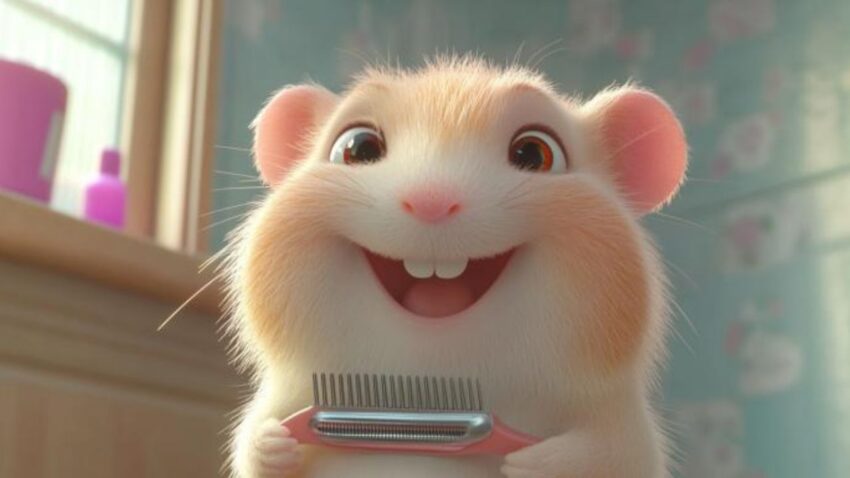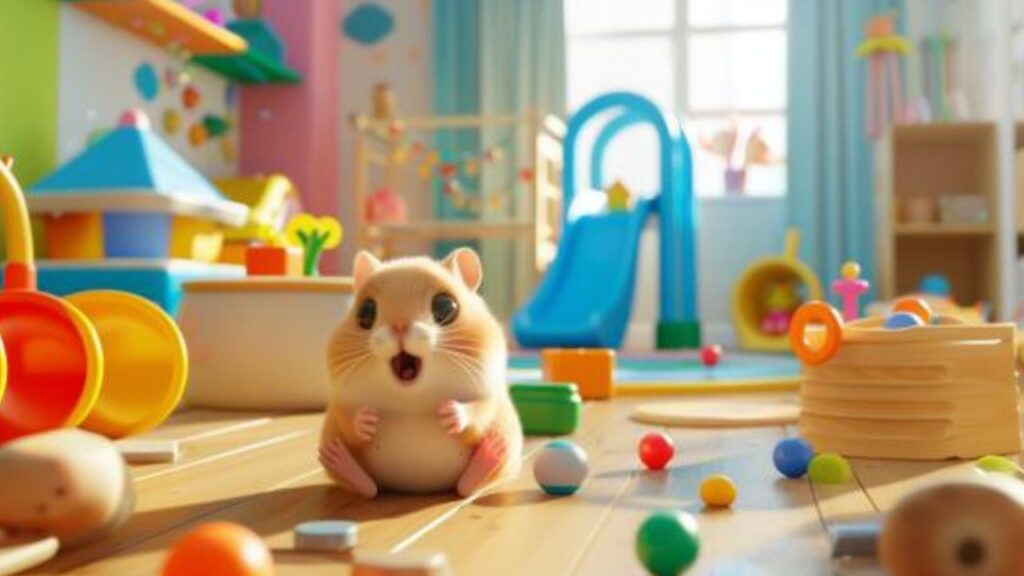Grooming is more than just a routine—it’s an essential part of keeping your hamster healthy and happy. Just like we brush our hair and trim our nails, your little furball needs regular grooming to look and feel their best. But, unlike us, hamsters can’t understand why we’re handling them, so it’s crucial that these grooming sessions are as calm and stress-free as possible. Let’s take a closer look at why this matters and how you can turn grooming into a positive experience for both you and your hamster.
The Significance of Grooming in a Hamster’s Routine
Grooming isn’t just about appearances; it plays a vital role in a hamster’s overall well-being. A well-groomed hamster is less likely to suffer from skin issues, matted fur, or overgrown nails—all of which can lead to discomfort or more serious health problems if left unchecked. Regular grooming helps to keep your hamster’s coat clean and their nails at a manageable length, preventing potential injuries that could occur from catching overgrown nails on bedding or cage accessories.
However, grooming is more than just a physical necessity. It’s also a key opportunity to check on your hamster’s health. During these sessions, you can examine their fur and skin for any signs of parasites, infections, or abnormalities like lumps or bumps. By maintaining a regular grooming routine, you’re ensuring that any health issues are caught early, giving your hamster the best chance of staying healthy and happy.
How Grooming Impacts a Hamster’s Well-Being
While grooming is essential, it’s also a potential source of stress for your hamster if not handled correctly. Hamsters are prey animals by nature, and being held or restrained, even for something as simple as grooming, can trigger their fight-or-flight response. This stress isn’t just unpleasant—it can have real health consequences. Prolonged stress in hamsters can lead to weakened immune systems, changes in eating habits, and even behavioral issues.
That’s why staying calm and ensuring your hamster is comfortable during grooming sessions is so important. A calm hamster is easier to handle and more likely to cooperate, making the process quicker and more effective. Moreover, reducing stress during grooming contributes to your hamster’s overall mental and physical well-being, helping to keep them happy and healthy in the long run.
Grooming as a Bonding Opportunity
Beyond the health benefits, grooming is also a unique opportunity to strengthen the bond between you and your hamster. When done correctly, grooming can become a time of connection rather than a dreaded chore. By approaching grooming sessions with patience and gentleness, you’re teaching your hamster to trust you, reinforcing that you’re a source of comfort rather than stress.
Picture this: a quiet evening, your hamster nestled comfortably in your hand as you gently brush their fur. You’re speaking softly to them, perhaps offering a small treat as a reward. Over time, these moments of calm connection can build trust, making future grooming sessions easier and more enjoyable for both of you.
Understanding Hamster Behavior During Grooming

When it comes to grooming your hamster, understanding their behavior is half the battle. Hamsters are small, sensitive creatures with natural instincts that influence how they respond to being handled. To make grooming a positive experience, it’s important to recognize these instincts, identify signs of stress, and understand why your hamster might resist grooming. By getting to know your hamster’s behavior better, you’ll be better equipped to keep them calm and comfortable during grooming sessions.
The Natural Instincts at Play
Hamsters, like all animals, are guided by their natural instincts, which have evolved over thousands of years. In the wild, hamsters are prey animals, meaning they are always on high alert for potential threats. This heightened sense of danger is hardwired into their behavior and plays a significant role in how they react to being handled, especially during grooming.
When you pick up your hamster for grooming, their first instinct might be to perceive you as a potential predator. This can trigger a stress response, causing them to become fidgety, anxious, or even aggressive. Understanding this instinctual behavior is crucial for making grooming sessions less stressful.
Scientific Insight: Stress Responses in Small Mammals
Studies on small mammals, including hamsters, have shown that stress can significantly impact their overall well-being. According to research, when small mammals experience stress, their bodies release a hormone called cortisol. Elevated cortisol levels over time can lead to various health issues, such as weakened immune systems, weight loss, and behavioral changes.
One study on stress responses in small mammals found that gentle handling and a calm environment can help reduce cortisol levels, making the animal more relaxed. This insight is particularly relevant for grooming, as it suggests that a gentle, patient approach can help mitigate your hamster’s natural stress response.
Case Study: Nibbles the Nervous Hamster
Let’s take a look at Nibbles, a particularly nervous Syrian hamster who had a hard time with grooming. Every time Nibbles’ owner tried to brush him, he would squirm, squeak, and try to escape. Understanding that Nibbles’ behavior was driven by fear, his owner decided to take a different approach.
Instead of rushing the grooming process, Nibbles’ owner started by simply letting Nibbles sniff and explore the brush without any pressure. Over time, Nibbles became more comfortable with the tool and began to associate it with positive experiences like treats and gentle petting. By respecting Nibbles’ natural instincts and giving him time to adjust, his owner was able to reduce his stress and make grooming a much more pleasant experience.
Signs of Stress vs. Signs of Comfort
Being able to recognize whether your hamster is stressed or comfortable during grooming is key to making the experience as smooth as possible. Hamsters, while small, communicate a lot through their body language and vocalizations, and these signals can tell you how they’re feeling.
Key Behaviors: What to Look For
When a hamster is stressed, you might notice behaviors such as:
- Rapid breathing or panting
- Trembling or shaking
- Flattening their body close to the ground
- Excessive squeaking or chattering
- Attempting to escape or hide
On the other hand, a comfortable hamster might:
- Be calm and still
- Move slowly and deliberately
- Groom themselves during or after your handling
- Nibble on food or accept treats
- Close their eyes or appear relaxed
Recognizing these signs can help you adjust your approach during grooming. For example, if you notice signs of stress, it might be best to take a break and let your hamster calm down before continuing. On the other hand, signs of comfort can indicate that your hamster is relaxed and ready to proceed.
Observational Tips: Reading Your Hamster’s Body Language
Reading your hamster’s body language is a skill that will improve over time. Here are a few tips to help you get started:
- Watch the ears: A hamster with relaxed ears is usually calm, while pinned-back ears can indicate fear or discomfort.
- Check the tail: A stiff, upright tail can be a sign of tension, whereas a relaxed tail usually indicates calmness.
- Listen for vocalizations: Squeaks, chattering, or hissing are signs of distress, while silence or soft sounds might suggest that your hamster is comfortable.
Visual Aid: Stress Indicators vs. Comfort Signs
| Stress Indicators | Comfort Signs |
|---|---|
| Rapid breathing | Slow, steady breathing |
| Trembling | Calm and still |
| Flattening to the ground | Moving slowly |
| Excessive squeaking | Accepting treats |
| Trying to escape or hide | Grooming themselves |
Why Hamsters Resist Grooming
Even with the best intentions, some hamsters might still resist grooming. Understanding the reasons behind this resistance can help you address the issue more effectively.
Behavioral Analysis: Common Reasons for Resistance
- Fear: As prey animals, hamsters are naturally wary of being restrained. They might associate being held with danger, which can cause them to resist grooming.
- Discomfort: Grooming tools, such as brushes or nail clippers, might feel uncomfortable or unfamiliar, leading to resistance.
- Unfamiliarity: If your hamster isn’t used to being handled or groomed, they might resist simply because the experience is new and strange.
Understanding these reasons can help you develop strategies to make grooming more acceptable to your hamster. For instance, introducing grooming tools gradually or handling your hamster regularly outside of grooming sessions can help reduce fear and unfamiliarity.
Personal Anecdote: The Tale of Whiskers the Fussy Hamster
Let me tell you about Whiskers, a particularly fussy dwarf hamster who would do anything to avoid grooming. Whiskers was notorious for wriggling out of his owner’s hands and hiding under his bedding whenever the grooming tools came out. His owner quickly realized that Whiskers’ resistance was due to fear and discomfort with the grooming process.
To help Whiskers feel more at ease, his owner decided to turn grooming into a game. She started by letting Whiskers explore the brush during playtime, turning it into a fun toy rather than a scary tool. Slowly but surely, Whiskers began to accept the brush, and grooming became less of a struggle. By understanding Whiskers’ behavior and working with it rather than against it, his owner was able to turn a dreaded task into a more enjoyable experience for both of them.
Preparing Your Hamster for a Calm Grooming Session

Before you even pick up a brush or pair of nail clippers, it’s essential to prepare both your hamster and the environment for a calm grooming session. The right setting, gentle handling, and proper introduction to grooming tools can make all the difference in reducing your hamster’s stress and ensuring a smooth, pleasant experience.
Creating a Stress-Free Environment
Setting the stage for a calm grooming session begins with the environment. A quiet, familiar space can help your hamster feel safe and reduce the anxiety that often accompanies grooming.
Setting the Stage: The Importance of a Quiet, Familiar Environment
Hamsters are creatures of habit, and they thrive in environments that are familiar and predictable. Sudden changes in their surroundings, loud noises, or bright lights can be overwhelming, triggering their natural stress responses. Therefore, it’s crucial to choose a spot where your hamster feels comfortable and secure.
A familiar environment helps to minimize the number of new stimuli your hamster has to process during grooming. This could be a quiet corner of the room where they spend most of their time or a specific area where they’re accustomed to being handled. The goal is to create a space where your hamster feels at ease, so the grooming process isn’t overshadowed by environmental stressors.
Scientific Insight: The Impact of Environmental Stressors on Small Animals
Research shows that small animals, including hamsters, are highly sensitive to environmental changes. A study on the effects of environmental stressors on small mammals found that factors such as noise, bright lights, and unfamiliar surroundings can elevate stress hormone levels, leading to increased anxiety and behavioral changes.
In particular, loud noises and sudden movements were found to be significant stressors for small mammals. These stressors can cause a heightened state of alertness, making it difficult for the animal to relax, which is crucial for a successful grooming session. By controlling the environment and minimizing these stressors, you can help your hamster stay calm and more receptive to grooming.
Practical Tips: Creating a Calming Space
To create a calming space for grooming, consider the following tips:
- Choose a Quiet Area: Select a spot away from household noise and foot traffic. This could be a quiet corner in a room or even a small, enclosed space where your hamster feels secure.
- Dim the Lights: Bright lights can be overwhelming for hamsters. Use soft, indirect lighting to create a more soothing atmosphere. If possible, use a lamp with a dimmer switch to adjust the brightness to a comfortable level.
- Introduce Calming Sounds: Gentle background noise, like soft classical music or nature sounds, can help mask any sudden noises and create a more peaceful environment. However, be sure to avoid any sounds that are too loud or startling.
- Familiar Scents: If your hamster has a favorite blanket or piece of bedding, include it in the grooming area. The familiar scent can provide comfort and help your hamster feel more at ease.
Gentle Handling Techniques
Handling your hamster with care is vital to keeping them calm during grooming. The way you hold and touch your hamster can either increase their stress or help them relax, so it’s important to use gentle, soothing techniques.
Techniques Overview: The Importance of Gentle Handling
Hamsters are delicate creatures, and rough or sudden handling can easily scare them. Gentle handling involves slow, deliberate movements that help your hamster feel secure rather than threatened. The goal is to build trust with your hamster, so they learn to associate being handled with positive experiences rather than fear.
Scientific Insight: The Power of Touch in Reducing Stress
Studies on the effects of touch in small mammals have shown that gentle, consistent handling can significantly reduce stress levels. Research indicates that animals who are regularly and gently handled show lower levels of stress hormones compared to those who are handled infrequently or harshly.
One study found that small mammals who were gently stroked and held exhibited calmer behavior and were more likely to accept handling without resistance. This suggests that the right kind of touch can have a calming effect, making your hamster more comfortable during grooming sessions.
Step-by-Step Guide: How to Gently Handle Your Hamster During Grooming
- Approach Slowly: Start by slowly approaching your hamster’s cage. Speak softly to let them know you’re there. Sudden movements or loud voices can startle them.
- Offer Your Hand: Gently place your hand in the cage, allowing your hamster to come to you. This gives them control and helps build trust.
- Lift Carefully: Once your hamster is comfortable, gently cup your hands around their body, supporting their weight. Lift them slowly and smoothly, keeping them close to your body for added security.
- Hold Securely: Hold your hamster securely but gently. Avoid squeezing too tightly, as this can cause discomfort. Instead, support their body with one hand while using the other to perform the grooming tasks.
- Move Deliberately: When grooming, make slow, deliberate movements. Sudden or jerky motions can startle your hamster, so try to keep your actions smooth and predictable.
- Watch for Signs of Discomfort: Pay attention to your hamster’s body language. If they start to squirm or show signs of stress, it’s important to pause and let them calm down before continuing.
Getting Your Hamster Accustomed to Grooming Tools
Introducing your hamster to grooming tools can be a delicate process, especially if they’re not used to being handled or groomed. Gradually familiarizing them with these tools can help reduce fear and make grooming a more comfortable experience.
Tool Introduction: The Importance of Gradual Exposure
For a hamster, grooming tools like brushes and nail clippers can be intimidating objects. If introduced too quickly, these tools can become a source of fear and stress. However, by gradually exposing your hamster to these tools, you can help them become more comfortable with the grooming process.
Start by simply placing the tools near your hamster during playtime or while they’re exploring. Let them sniff and investigate the tools at their own pace. This initial exposure helps to reduce the fear of the unknown and allows your hamster to get used to the sight and smell of the tools before they’re ever used on them.
Desensitization Techniques: Using Positive Reinforcement
Desensitization involves slowly introducing your hamster to the grooming tools while associating them with positive experiences, like treats or gentle petting. This technique helps to create a positive association with the tools, reducing the likelihood of resistance during grooming.
Here’s how you can desensitize your hamster to grooming tools:
- Step 1: Introduce the Tools: Start by placing the grooming tools in your hamster’s environment, such as near their play area or in their cage. Let your hamster investigate the tools without any pressure.
- Step 2: Offer Treats: Whenever your hamster approaches or sniffs the grooming tools, reward them with a small treat. This helps to create a positive association with the tools.
- Step 3: Gradual Contact: Once your hamster is comfortable with the presence of the tools, begin to gently touch them with the tools during handling. For example, you can lightly brush their fur with the back of the brush. Continue to offer treats and praise.
- Step 4: Practice Short Sessions: Begin with very short grooming sessions using the tools. Gradually increase the duration as your hamster becomes more comfortable, always rewarding them for their cooperation.
Hannah’s Training Tactics

When it comes to grooming your hamster, a few thoughtful techniques can make all the difference in keeping the experience calm and enjoyable for both you and your furry friend. Here are some of my favorite quick tips to help you and your hamster get the most out of your grooming sessions.
Quick Tip 1: Start Grooming Sessions with a Calming Scent
One simple yet effective way to set the tone for a calm grooming session is by introducing a soothing scent into the environment. Scents like lavender are known for their calming properties, not just in humans, but also in animals. Before you begin grooming, place a drop of lavender essential oil on a cloth and keep it nearby. The gentle aroma can help create a peaceful atmosphere, making your hamster more relaxed and receptive to the grooming process.
However, it’s important to remember that hamsters have very sensitive respiratory systems. Never apply essential oils directly on your hamster or too close to their nose. Keeping the scented cloth nearby, rather than in direct contact with your hamster, is a safe way to enjoy the calming benefits without overwhelming their senses.
Quick Tip 2: Use a Soft Brush That’s Similar in Texture to Their Bedding
Choosing the right grooming tool can make a big difference in how your hamster reacts during grooming. A soft brush that closely resembles the texture of your hamster’s bedding can be especially comforting. This familiar sensation helps your hamster feel at ease, as it mimics the textures they’re already accustomed to in their environment.
When selecting a brush, look for one with soft bristles that won’t tug or pull at your hamster’s fur. The goal is to create a soothing experience, not one that feels foreign or uncomfortable. By using a brush that feels similar to their bedding, you’re more likely to keep your hamster calm and cooperative during grooming sessions. Over time, your hamster may even start to enjoy these sessions as a natural extension of their regular grooming and burrowing activities.
Quick Tip 3: Make Grooming a Social Time
Grooming doesn’t have to be a strictly utilitarian task—it can also be an opportunity for bonding with your hamster. Turn grooming into a social activity by incorporating treats and gentle talking. Start by offering a favorite treat before and after grooming to create a positive association with the process. This reward system helps reinforce good behavior and makes your hamster look forward to grooming sessions.
Additionally, talking softly to your hamster during grooming can be incredibly soothing. Your voice is a familiar sound, and speaking gently can help keep your hamster calm. Consider using a low, steady tone, as high-pitched or loud noises might startle your hamster. Combine this with slow, deliberate movements, and your hamster will soon associate grooming time with positive social interaction, rather than just a routine task.
Conclusion: Wrapping Up Your Grooming Session

Grooming your hamster is much more than a simple act of care—it’s an opportunity to strengthen the bond between you and your little friend. As you’ve learned, the key to a successful grooming session lies in patience, consistency, and understanding your hamster’s unique needs and behaviors. By approaching grooming with these principles in mind, you’ll help ensure that your hamster remains calm, comfortable, and happy.
Final Thoughts: Patience and Consistency Are Key
Grooming isn’t something that your hamster will necessarily take to right away, especially if they’re not used to being handled frequently. This is where patience truly becomes your greatest tool. It’s important to go at your hamster’s pace, slowly introducing them to the grooming process in a way that makes them feel secure.
Consistency is equally important. Regular grooming sessions not only help maintain your hamster’s health but also build a routine that they can come to expect and even enjoy. The more consistent you are with these sessions, the more your hamster will learn to trust the process, reducing their stress and making grooming easier over time.
Remember, every hamster is different. Some may take to grooming quickly, while others may need a little more time and encouragement. The most important thing is to stay patient, gentle, and consistent, creating a positive experience that reinforces the bond you share.
Encouragement: It’s Okay if It Takes Time
If your hamster doesn’t immediately take to grooming, don’t be discouraged. It’s perfectly normal for them to need time to adjust to new experiences. The key is to be gentle and persistent, giving them the time they need to become comfortable with each step of the grooming process.
Think of each grooming session as a learning opportunity—not just for your hamster, but for you as well. With each session, you’ll learn more about what works best for your hamster, helping you refine your approach and improve the experience for both of you. Even if progress is slow, remember that every small step forward is a victory.
So, take a deep breath, go at your hamster’s pace, and know that with time, patience, and plenty of positive reinforcement, your hamster will become more comfortable with grooming. And who knows? You might even find that grooming becomes one of your favorite times to bond with your furry friend.
With paws and patience, you’re on the road to being a Hamster Whisperer. Happy training!




